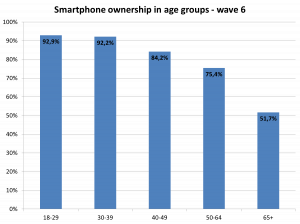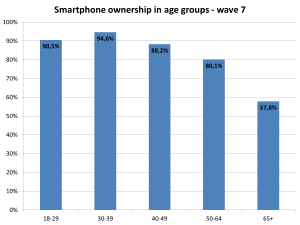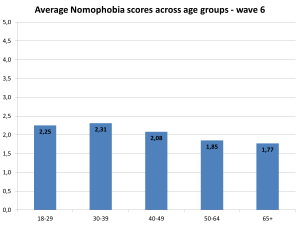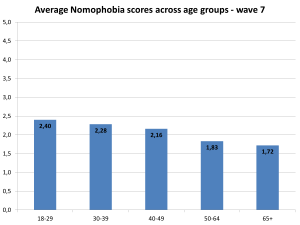The use of smartphones has become ubiquitous for large parts of the population in Europe. As smartphones are also commonly used to access social network sites, we decided to take a look at the use of smartphones in the latest waves of our longitudinal study. We first asked our respondents whether they own a smartphone. Out of the 1330 person who participated in the 6th wave of our survey, 72.8% reported that they currently own a smartphone. The share of smartphone owners slightly increased in wave 7 with 76.5% of the sample reporting ownership.
As can be expected, smartphone ownership was more common among younger internet users (see Figures 1 & 2).
As with all new media and devices that become popular, there is a public and academic debate about the causes, prevalence, and consequences of excessive or potentially harmful smartphone use. A term that has been coined in this context is nonomphobia. Nomophobia is an abbreviation for “no-mobile(-phone) phobia” and the describes the fear of losing or not having access to one’s mobile phone.
To assess the prevalence of nomophobia among the smartphone owners in our sample we included 8 items from the No Mobile Phone Questionnaire (NMP-Q) by Yildirim & Correia (2015). The answering options for these items ranged from 1 to 5, with 5 indicating high agreement and, thus, higher nomophobia. The overall averages for nomophobia were quite low in our sample: 2 (out of a maximum score of 5) in wave 6 and 1.98 in wave 7. There were no noticeable differences in the overall nomophobia scores between men and women in either wave 6 (men = 2.07/women = 1.9) or wave 7 (men = 2.05/women = 1.9).
Again, nomophobia was more common among younger internet users; which is not surprising, given that smartphone ownership and use are also more widespread in these groups. However, these differences were also quite small (see Figures 3 & 4).
When looking at the scores for the individual nomophobia items, the statement “If I did not have my smartphone with me, I would feel anxious because I could not instantly communicate with my family and/or friends” reached the highest average agreement (mean = 2.59 in wave 6 and 2.57 in wave 7), followed by the item “If I did not have my smartphone with me, I would feel nervous because I would not be able to receive text messages and calls” (mean = 2.15 in wave 6 and 2.1 in wave 7). All of the remaining six items reached average agreement scores around or slightly below 2 (on a 5-point scale). It seems that the ability to continuously communicate with others and being contactable are the most important factors.
Overall, our data indicate that nomophobia is not as widespread as the media reports about this phenomenon would suggest. While the answers in our survey may have been influenced by social desirability and signs of nomophobia are slightly more common among younger internet users, the overall averages are quite low. Hence, it seems that there is no need to be afraid of a nomophobia epidemic.




